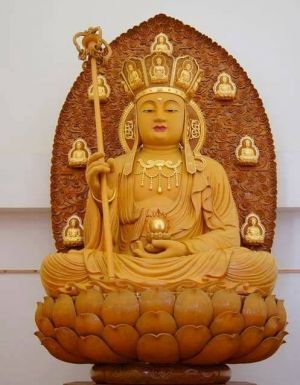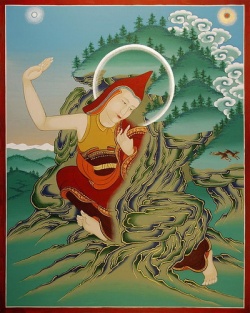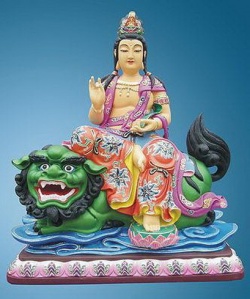Difference between revisions of "Tertön"
m (Text replacement - "]]]" to "]])") |
|||
| Line 1: | Line 1: | ||
| + | [[File:848729.jpg|thumb]] | ||
[[Image:Bhutanese painted thanka of Guru Nyima Ozer, late 19th century, Do Khachu Gonpa, Chukka, Bhutan.jpg|thumb|200px|{{Wiki|Bhutanese}} painted [[thangka]] of [[Tertön]] [[Padmasambhava]], late 19th century, Do Khachu [[Gonpa]], Mebisa, [[Bhutan]])] | [[Image:Bhutanese painted thanka of Guru Nyima Ozer, late 19th century, Do Khachu Gonpa, Chukka, Bhutan.jpg|thumb|200px|{{Wiki|Bhutanese}} painted [[thangka]] of [[Tertön]] [[Padmasambhava]], late 19th century, Do Khachu [[Gonpa]], Mebisa, [[Bhutan]])] | ||
| Line 21: | Line 22: | ||
| − | * | + | *[[Padmasambhava]] (1124–1192), |
| − | * | + | *[[Guru Chowang]] (1212–1270), |
| − | * | + | *[[Rigdzin Gödem]] (1307–1408), |
| − | * | + | *[[Dorje Lingpa]] (1346-1405), |
| − | * | + | *[[Ratna Lingpa]] (1403–1478), |
| − | * | + | *[[Pema Lingpa]] (1450–1521), |
| − | * | + | *[[Migyur Dorje]] (1645–1667), |
| − | * | + | *and [[Jigme Lingpa]] (1729-1798), |
| − | * | + | *[[Jamyang Khyentse Wangpo]] (1820–1892) |
| − | * | + | *and [[Orgyen Chokgyur Lingpa]] (1829–1870). |
| − | + | :The "seal" of all [[tertöns]] is said to have been [[Jamyang Khyentse Wangpo]] (1820-1892). | |
| − | : | ||
| Line 49: | Line 49: | ||
| − | + | *[[Nyangral Nyima Özer]] (1124-1192) | |
| − | * | + | *[[Guru]] [[Chökyi Wangchuk]] (1212-1270) |
| − | * | + | *[[Dorje Lingpa]] (1346-1405) |
| − | * | + | *[[Pema Lingpa]] (1445/50-1521) |
| − | * | + | *[[Jamyang Khyentse Wangpo]] (1820-1892) |
| − | * | ||
| Line 60: | Line 59: | ||
| − | + | ==[[Tertön practices]]== | |
| − | == [[Tertön practices]]== | ||
| Line 68: | Line 66: | ||
| − | : | + | :One of the special requirements for the discovery of [[termas]] is the inspiration of the {{Wiki|feminine}} [[principle]], just as it was necessary for their [[concealment]]. |
The great majority of [[tertöns]] have been men, and generally they are accompanied by their wives or {{Wiki|female}} companions (who need not necessarily have a {{Wiki|sexual}} relationship with them). | The great majority of [[tertöns]] have been men, and generally they are accompanied by their wives or {{Wiki|female}} companions (who need not necessarily have a {{Wiki|sexual}} relationship with them). | ||
| Line 77: | Line 75: | ||
'''[[Tertön]]''' ([[Wyl.]] [[gter ston]]) — a [[revealer of spiritual treasures]] ([[terma]]) hidden by [[Guru Rinpoche]] and [[Yeshe Tsogyal]] for the {{Wiki|benefit}} of {{Wiki|future}} generations. | '''[[Tertön]]''' ([[Wyl.]] [[gter ston]]) — a [[revealer of spiritual treasures]] ([[terma]]) hidden by [[Guru Rinpoche]] and [[Yeshe Tsogyal]] for the {{Wiki|benefit}} of {{Wiki|future}} generations. | ||
| − | |||
| Line 92: | Line 89: | ||
| − | * | + | *the lady [[Jomo Menmo]] (1248–1283), the [[spiritual]] [[consort]] of [[Guru]] [[Chöwang]]; |
| − | * | + | *[[Orgyen Lingpa]] (1323–c.1360), discoverer of the {{Wiki|biography}} of [[Guru Rinpoche]], the [[Sheldrakma]], and the [[Kathang De Nga]]; |
| − | * | + | *[[Rigdzin Gödem]] (1337–1403), discoverer of the [[Northern Treasures]]; |
| − | * | + | *[[Sangyé Lingpa]] (1340–1396), who revealed the [[Lama Gongdü cycle]]; |
| − | * | + | *[[Karma Lingpa]] (14th. century), the discoverer of the [[Shyitro Gongpa Rangdrol]] cycle, from which come the teachings on the ‘[[Six Bardos]]’ and the [[Bardo Thödrol Chenmo]]; |
| − | * | + | *[[Ratna]] Lingpa (1403–1478) who compiled the [[Nyingma Gyübum]]; |
| − | * | + | *[[Thangtong Gyalpo]] (1385–1510), the [[extraordinary]] {{Wiki|mystic}} and engineer who lived to the age of one hundred and twenty five; |
| − | * | + | *[[Jatsön Nyingpo]] (1585–1656), who revealed the [[Könchok Chidü cycle]]; |
| − | * | + | *[[Lhatsün Namkha Jikmé]] (1597–c.1650), the discoverer of the [[Rigdzin Sokdrup]] teachings; |
| − | * | + | *the Great [[Fifth Dalai Lama]], [[Ngawang Lobsang Gyatso]] (1617–1682), who received the [[twenty-five teachings]] known as [[Sangwa Gyachen]] in [[pure vision]] and his [[disciple]] and [[teacher]] [[Terdak Lingpa]] (1646-1714). |
{{W}} | {{W}} | ||
| − | |||
[[Category:Buddhist Terms]] | [[Category:Buddhist Terms]] | ||
Revision as of 19:46, 19 December 2020
[[Image:Bhutanese painted thanka of Guru Nyima Ozer, late 19th century, Do Khachu Gonpa, Chukka, Bhutan.jpg|thumb|200px|Bhutanese painted thangka of Tertön Padmasambhava, late 19th century, Do Khachu Gonpa, Mebisa, Bhutan)]
A tertön (Tibetan: གཏེར་སྟོན་, Wylie: gter ston) is a discoverer of ancient texts or "Terma". Many tertöns are considered incarnations of the 25 main disciples of Padmasambhava.
A vast system of transmission lineages developed. Nyingma scriptures were updated by Terma discoveries, and Terma teachings have guided many Buddhist and Bön practitioners.
Prominent tertöns
According to generally accepted history, the rediscovering of Terma began with the first tertön, Sangye Lama (1000–1080).
Tertöns of outstanding importance were
- Padmasambhava (1124–1192),
- Guru Chowang (1212–1270),
- Rigdzin Gödem (1307–1408),
- Dorje Lingpa (1346-1405),
- Ratna Lingpa (1403–1478),
- Pema Lingpa (1450–1521),
- Migyur Dorje (1645–1667),
- and Jigme Lingpa (1729-1798),
- Jamyang Khyentse Wangpo (1820–1892)
- and Orgyen Chokgyur Lingpa (1829–1870).
- The "seal" of all tertöns is said to have been Jamyang Khyentse Wangpo (1820-1892).
In one of his visions, he could clearly see all the Terma that were hidden throughout Tibet and other countries.
He was the only master in Tibetan history to have not only received, but also transmitted the "seven transmissions" (bka' babs bdun), that are the canonical teachings, treasures taken from the earth,
reconcealed treasures, mind treasures, recollections, pure visions, and aural transmissions received in visions. (Ricard, undated).
In the 8th century, Padmasambhava predicted that in the future hundreds of tertöns would spread his teachings.
Throughout the centuries many more people were known as tertön. Five of them were widely recognized as very important ones and called the "five tertön kings:"
- Nyangral Nyima Özer (1124-1192)
- Guru Chökyi Wangchuk (1212-1270)
- Dorje Lingpa (1346-1405)
- Pema Lingpa (1445/50-1521)
- Jamyang Khyentse Wangpo (1820-1892)
Another noteworthy tertön is Tsangpa Gyare, founder of the Drukpa Lineage (12th century).
Tertön practices
Consorts, with whom they practice sexual yoga to accelerate and enhance their capacity for realization, are thought to be very important to tertöns. Fremantle (2001: p. 19) states that:
- One of the special requirements for the discovery of termas is the inspiration of the feminine principle, just as it was necessary for their concealment.
The great majority of tertöns have been men, and generally they are accompanied by their wives or female companions (who need not necessarily have a sexual relationship with them).
Alternatively, something representing the tertön's complementary energy, whether male or female, must be present.
Tertön (Wyl. gter ston) — a revealer of spiritual treasures (terma) hidden by Guru Rinpoche and Yeshe Tsogyal for the benefit of future generations.
Major Tertöns
Starting with the first tertön, Sangyé Lama (1000–1080) and Drapa Ngönshé (1012–90), discoverer of the Four Medical Tantras, there have been hundreds of masters who specialized in the discovery of terma, continuing up until the present day with Kyabjé Dudjom Rinpoche and Kyabjé Dilgo Khyentse Rinpoche.
There are said to be one hundred great tertöns and one thousand minor ones, of whom five in particular are known as the ‘Five Sovereigns’:
Other famous terma masters were:
- the lady Jomo Menmo (1248–1283), the spiritual consort of Guru Chöwang;
- Orgyen Lingpa (1323–c.1360), discoverer of the biography of Guru Rinpoche, the Sheldrakma, and the Kathang De Nga;
- Rigdzin Gödem (1337–1403), discoverer of the Northern Treasures;
- Sangyé Lingpa (1340–1396), who revealed the Lama Gongdü cycle;
- Karma Lingpa (14th. century), the discoverer of the Shyitro Gongpa Rangdrol cycle, from which come the teachings on the ‘Six Bardos’ and the Bardo Thödrol Chenmo;
- Ratna Lingpa (1403–1478) who compiled the Nyingma Gyübum;
- Thangtong Gyalpo (1385–1510), the extraordinary mystic and engineer who lived to the age of one hundred and twenty five;
- Jatsön Nyingpo (1585–1656), who revealed the Könchok Chidü cycle;
- Lhatsün Namkha Jikmé (1597–c.1650), the discoverer of the Rigdzin Sokdrup teachings;
- the Great Fifth Dalai Lama, Ngawang Lobsang Gyatso (1617–1682), who received the twenty-five teachings known as Sangwa Gyachen in pure vision and his disciple and teacher Terdak Lingpa (1646-1714).


